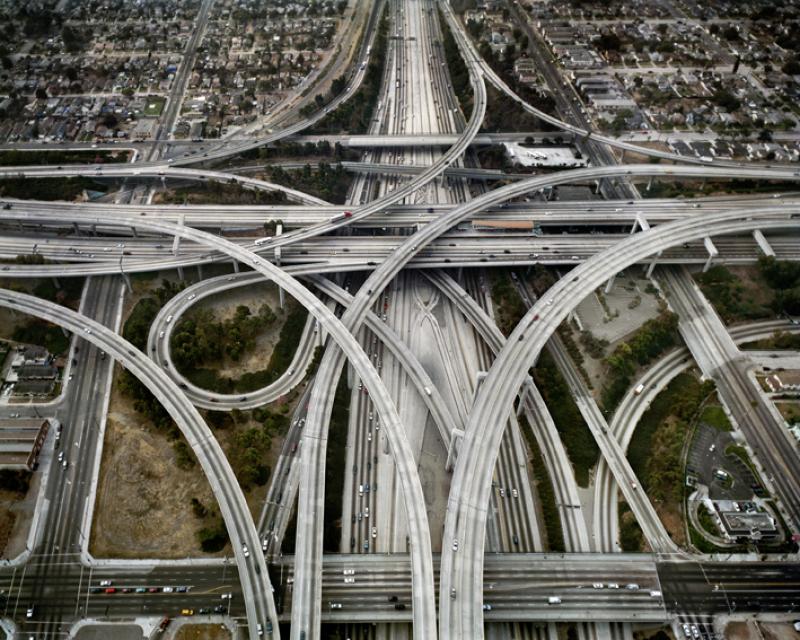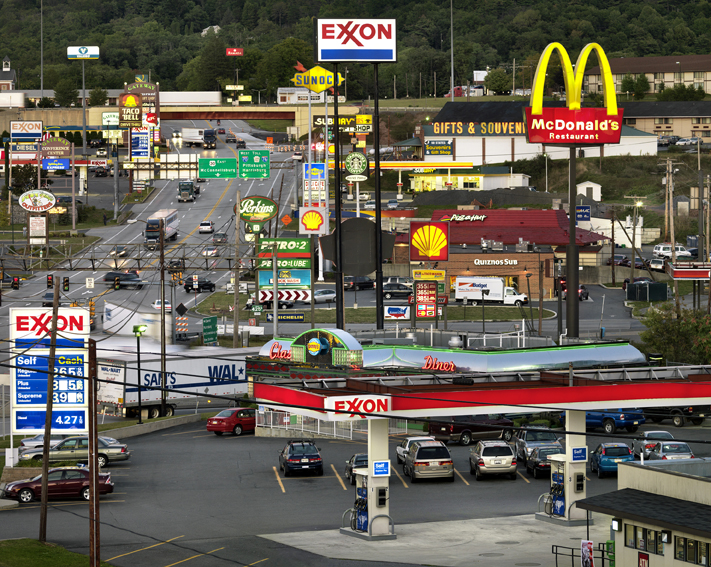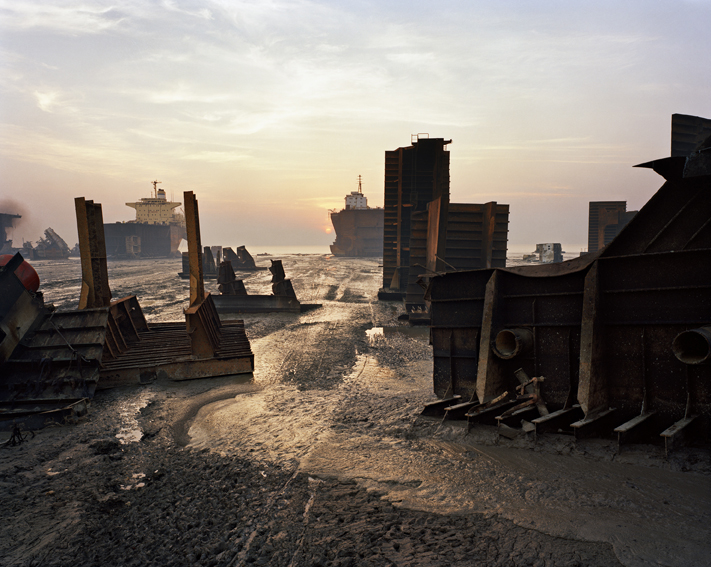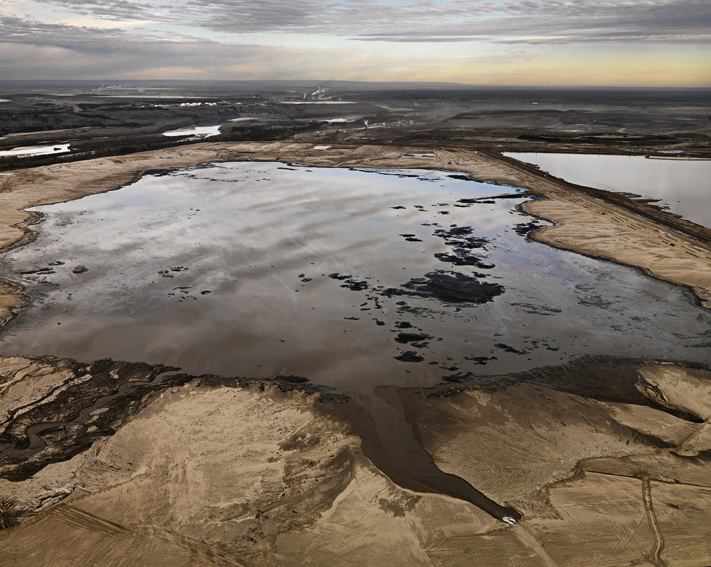Burtynsky: OIL, The Photographers' Gallery | reviews, news & interviews
Burtynsky: OIL, The Photographers' Gallery
Burtynsky: OIL, The Photographers' Gallery
Exhibition space reopens with a show examining the life cycle of black gold

After a £9.2 million renovation of its new home on Ramillies Street by the Irish architects O’Donnell + Tuomey, the Photographers’ Gallery re-opened to the public on Saturday with a slick new look and an expertly curated exhibition of works by the veteran Canadian photographer Edward Burtynsky.
The original Victorian warehouse has been extended by two storeys, a move that has both doubled the previous exhibition space as well as transforming the site into a grand six-floor venue for photography in the centre of London. This modern extension is linked to the original red-brick building by an external black sleeve that supports the new steel-framed extension - an elegant move that preserves the beautiful brick facade while showcasing the steel’s clean lines. The extension also playfully makes reference to the body of a camera, with large feature windows which function like apertures or viewfinders to the landscape of surrounding Soho.
 The primary exhibition space at the top of the building is given over to the exhibition Burtynsky: OIL, a selection of over 30 works from Burtynsky’s 15-year project devoted to exploring the impact of oil on our lives (the full series is now also available as an iPad app). The subject of the show, in brief, is the life cycle of oil - ironically a resource that is produced from decaying matter. The subject of Burtynsky’s series is hardly revolutionary - the positive and negative impact of oil on our lives ranging from buses and lotions to the destruction of natural habitats and war is a well-aired topic. But to read Burtynsky’s images purely through the line of political or environmental comment is to bypass the works themselves. These photographs are exquisite in their execution and detail, revealing a depth of complexity to those patient enough to meditate on the landscapes they depict. It is in fact from the simple point of landscape that one should approach Burtynsky’s photographs; the photographer captures the contemporary sublime with the tempered eloquence and drama of Turner or Caspar David Friedrich. (Pictured above left, Breezewood, Pennsylvania, USA, 2008)
The primary exhibition space at the top of the building is given over to the exhibition Burtynsky: OIL, a selection of over 30 works from Burtynsky’s 15-year project devoted to exploring the impact of oil on our lives (the full series is now also available as an iPad app). The subject of the show, in brief, is the life cycle of oil - ironically a resource that is produced from decaying matter. The subject of Burtynsky’s series is hardly revolutionary - the positive and negative impact of oil on our lives ranging from buses and lotions to the destruction of natural habitats and war is a well-aired topic. But to read Burtynsky’s images purely through the line of political or environmental comment is to bypass the works themselves. These photographs are exquisite in their execution and detail, revealing a depth of complexity to those patient enough to meditate on the landscapes they depict. It is in fact from the simple point of landscape that one should approach Burtynsky’s photographs; the photographer captures the contemporary sublime with the tempered eloquence and drama of Turner or Caspar David Friedrich. (Pictured above left, Breezewood, Pennsylvania, USA, 2008)
 The exhibition begins at the very top of the building with large-format photographs of oil fields filled with strangely motionless drills that stand like lonely giants in perfect formation across the desolate landscape as far as the eye can see. The images are rhythmic and strangely sad. Looking more closely you notice there are no humans in these first images, just the evidence of our presence in the monolithic and aggressive machines we construct to dig and pump the black oil out of the earth. From these lonely oil fields, Burtynsky moves onto to the mazes of pipe that take the crude oil to the refineries. Here the pipes are not so much foreboding as out of place in the lush natural landscape and for a moment one wonders if the images themselves are a collage of two different scenes - so out of place are the shiny silver tubes. Yet it was the next two photographs that caught my attention for the longest - images of the insides of the oil refineries. Here the multiple pipelines swirl together into neat geometric patterns as mesmerising as a neatly ordered abstract painting, yet silently cold, as if you are looking at images of an autopsy with the intestines of the factories laid bare under the flayed skin of the exterior. (Pictured above left: Shipbreaking #13, Chittagong, Bangladesh, 2000)
The exhibition begins at the very top of the building with large-format photographs of oil fields filled with strangely motionless drills that stand like lonely giants in perfect formation across the desolate landscape as far as the eye can see. The images are rhythmic and strangely sad. Looking more closely you notice there are no humans in these first images, just the evidence of our presence in the monolithic and aggressive machines we construct to dig and pump the black oil out of the earth. From these lonely oil fields, Burtynsky moves onto to the mazes of pipe that take the crude oil to the refineries. Here the pipes are not so much foreboding as out of place in the lush natural landscape and for a moment one wonders if the images themselves are a collage of two different scenes - so out of place are the shiny silver tubes. Yet it was the next two photographs that caught my attention for the longest - images of the insides of the oil refineries. Here the multiple pipelines swirl together into neat geometric patterns as mesmerising as a neatly ordered abstract painting, yet silently cold, as if you are looking at images of an autopsy with the intestines of the factories laid bare under the flayed skin of the exterior. (Pictured above left: Shipbreaking #13, Chittagong, Bangladesh, 2000)
 While the next section of the exhibition, titled “Transportation and Motor Culture”, is equally critical, there is also a cutting comedic bite. It is hard not to giggle after reading, Kiss Concert Parking Area. Sturgis, North Dakota 2008, the title of a photograph of lines of neatly parked motorcycles in a majestic desert landscape bathed in the orange glow of a sunset. While comical the photograph also suggesting that we no longer notice the space around us: so ravenous is our hunger for progress and spectacle, we care more about the concert. Next to images of intersecting freeways and overpasses - the arteries of modern living - Burtynsky often seems to ask us to consider what is forgotten, the bits of green that even in these photographs have been pushed to the edges, or lost completely in a sea of grey pavement. (Pictured above, Alberta Oil Sands #2, Fort McMurray, Alberta, Canada, 2007)
While the next section of the exhibition, titled “Transportation and Motor Culture”, is equally critical, there is also a cutting comedic bite. It is hard not to giggle after reading, Kiss Concert Parking Area. Sturgis, North Dakota 2008, the title of a photograph of lines of neatly parked motorcycles in a majestic desert landscape bathed in the orange glow of a sunset. While comical the photograph also suggesting that we no longer notice the space around us: so ravenous is our hunger for progress and spectacle, we care more about the concert. Next to images of intersecting freeways and overpasses - the arteries of modern living - Burtynsky often seems to ask us to consider what is forgotten, the bits of green that even in these photographs have been pushed to the edges, or lost completely in a sea of grey pavement. (Pictured above, Alberta Oil Sands #2, Fort McMurray, Alberta, Canada, 2007)
On the lower lever is the concluding section of the show “The End of Oil”. Here we see piles of used tyres and fighter-jet graveyards - perhaps the most “subtle” reference in the current show to the place of war in the oil industry - and then finally images of oil spills. One of the most arresting images here is of a man standing alone, confrontational in the centre of the photograph, in front of a vast oil tanker he is in the process of deconstructing. Flanked by two further images of these toxic “recycling” grounds for old oil tankers in Bangladesh one is struck by how apocalyptic these images feel. The partially stripped machines are emasculated, ghastly ruins of an industry which won’t simply put them to rest, but will break them down and push them to work again.
Explore topics
Share this article
The future of Arts Journalism
You can stop theartsdesk.com closing!
We urgently need financing to survive. Our fundraising drive has thus far raised £49,000 but we need to reach £100,000 or we will be forced to close. Please contribute here: https://gofund.me/c3f6033d
And if you can forward this information to anyone who might assist, we’d be grateful.

Subscribe to theartsdesk.com
Thank you for continuing to read our work on theartsdesk.com. For unlimited access to every article in its entirety, including our archive of more than 15,000 pieces, we're asking for £5 per month or £40 per year. We feel it's a very good deal, and hope you do too.
To take a subscription now simply click here.
And if you're looking for that extra gift for a friend or family member, why not treat them to a theartsdesk.com gift subscription?
more Visual arts
 'We are bowled over!' Thank you for your messages of love and support
Much-appreciated words of commendation from readers and the cultural community
'We are bowled over!' Thank you for your messages of love and support
Much-appreciated words of commendation from readers and the cultural community
 Folkestone Triennial 2025 - landscape, seascape, art lovers' escape
Locally rooted festival brings home many but not all global concerns
Folkestone Triennial 2025 - landscape, seascape, art lovers' escape
Locally rooted festival brings home many but not all global concerns
 Sir Brian Clarke (1953-2025) - a personal tribute
Remembering an artist with a gift for the transcendent
Sir Brian Clarke (1953-2025) - a personal tribute
Remembering an artist with a gift for the transcendent
 Emily Kam Kngwarray, Tate Modern review - glimpses of another world
Pictures that are an affirmation of belonging
Emily Kam Kngwarray, Tate Modern review - glimpses of another world
Pictures that are an affirmation of belonging
 Kiefer / Van Gogh, Royal Academy review - a pairing of opposites
Small scale intensity meets large scale melodrama
Kiefer / Van Gogh, Royal Academy review - a pairing of opposites
Small scale intensity meets large scale melodrama
 Jenny Saville: The Anatomy of Painting, National Portrait Gallery review - a protégé losing her way
A brilliant painter in search of a worthwhile subject
Jenny Saville: The Anatomy of Painting, National Portrait Gallery review - a protégé losing her way
A brilliant painter in search of a worthwhile subject
 Abstract Erotic, Courtauld Gallery review - sculpture that is sensuous, funny and subversive
Testing the boundaries of good taste, and winning
Abstract Erotic, Courtauld Gallery review - sculpture that is sensuous, funny and subversive
Testing the boundaries of good taste, and winning
 Edward Burra, Tate Britain review - watercolour made mainstream
Social satire with a nasty bite
Edward Burra, Tate Britain review - watercolour made mainstream
Social satire with a nasty bite
 Ithell Colquhoun, Tate Britain review - revelations of a weird and wonderful world
Emanations from the unconscious
Ithell Colquhoun, Tate Britain review - revelations of a weird and wonderful world
Emanations from the unconscious
 Rachel Jones: Gated Canyons, Dulwich Picture Gallery review - teeth with a real bite
Mouths have never looked so good
Rachel Jones: Gated Canyons, Dulwich Picture Gallery review - teeth with a real bite
Mouths have never looked so good
 Yoshitomo Nara, Hayward Gallery review - sickeningly cute kids
How to make millions out of kitsch
Yoshitomo Nara, Hayward Gallery review - sickeningly cute kids
How to make millions out of kitsch
 Hamad Butt: Apprehensions, Whitechapel Gallery review - cool, calm and potentially lethal
The YBA who didn’t have time to become a household name
Hamad Butt: Apprehensions, Whitechapel Gallery review - cool, calm and potentially lethal
The YBA who didn’t have time to become a household name

Add comment